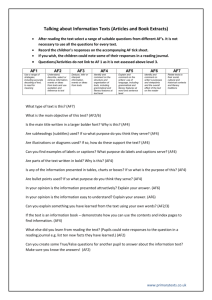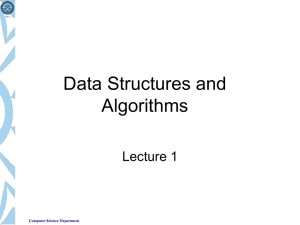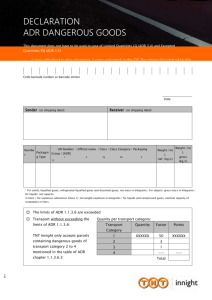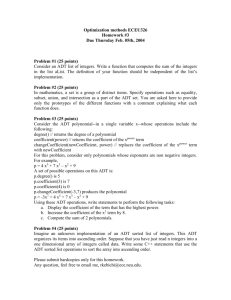Appendix S1. Details of the breakpoint procedure We estimated the
advertisement
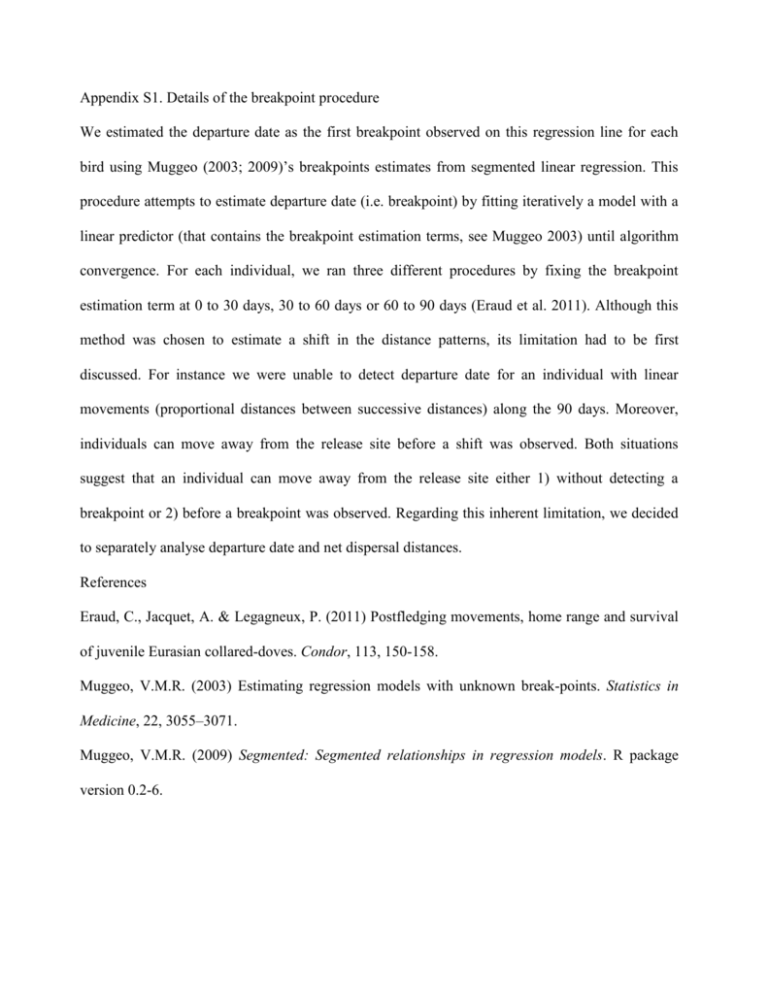
Appendix S1. Details of the breakpoint procedure We estimated the departure date as the first breakpoint observed on this regression line for each bird using Muggeo (2003; 2009)’s breakpoints estimates from segmented linear regression. This procedure attempts to estimate departure date (i.e. breakpoint) by fitting iteratively a model with a linear predictor (that contains the breakpoint estimation terms, see Muggeo 2003) until algorithm convergence. For each individual, we ran three different procedures by fixing the breakpoint estimation term at 0 to 30 days, 30 to 60 days or 60 to 90 days (Eraud et al. 2011). Although this method was chosen to estimate a shift in the distance patterns, its limitation had to be first discussed. For instance we were unable to detect departure date for an individual with linear movements (proportional distances between successive distances) along the 90 days. Moreover, individuals can move away from the release site before a shift was observed. Both situations suggest that an individual can move away from the release site either 1) without detecting a breakpoint or 2) before a breakpoint was observed. Regarding this inherent limitation, we decided to separately analyse departure date and net dispersal distances. References Eraud, C., Jacquet, A. & Legagneux, P. (2011) Postfledging movements, home range and survival of juvenile Eurasian collared-doves. Condor, 113, 150-158. Muggeo, V.M.R. (2003) Estimating regression models with unknown break-points. Statistics in Medicine, 22, 3055–3071. Muggeo, V.M.R. (2009) Segmented: Segmented relationships in regression models. R package version 0.2-6. Table S1. Details of the dispersal analysis sample (N = 436 individuals) of captive-bred houbara bustards with body weight, release age by years and by sex of the equipped birds. The mean release group size by years is also given. Male Female Year N Age (days) Body Weight (g) N Age (days) Body Weight (g) Release group size 2001 15 431 ± 98 1726 ± 101 14 351 ± 89 1160 ± 120 10 ± 3 2002 24 220 ± 97 1604 ± 170 24 254 ± 83 1124 ± 103 23 ± 9 2003 14 280 ± 120 1598 ± 161 34 242 ± 54 1122 ± 116 35 ± 11 2004 33 134 ± 11 1295 ± 164 14 126 ± 24 962 ± 120 86 ± 54 2005 19 207 ± 82 1376 ± 299 20 246 ± 80 1079 ± 132 40 ± 13 2006 47 241 ± 539 1586 ± 156 49 250 ± 52 1131 ± 116 72 ± 27 2007 9 191 ± 5 1564 ± 172 17 201 ± 30 1191 ± 75 134 ± 35 2008 31 217 ± 63 1454 ± 165 33 241 ± 66 1068 ± 151 221 ± 111 2009 17 196 ± 99 1200 ± 246 22 238 ± 90 937 ± 141 292 ± 101 Figure S1. Locations of the weather stations in Morocco. Houbara bustards were bred in two breeding stations, Missour and Enjil (respectively grey and white circles). Appendix S2. Model selection procedure of the linear mixed effect models For all models, we started from the global model (all explanatory variables and first order interactions) and compared its performance with submodels from which non-significant terms were deleted one at a time. Final model selection of fixed effects was conducted using Likelihood Ratio Tests (Lewis et al. 2010). As the appropriate number of degrees of freedom to use in assessing statistical significance in mixed-effects models is controversial (Baayen et al. 2008), we present coefficients of the selected models (from model sets 1, 2 and 4) with estimates of highest posterior density (HPD) intervals, which are Bayesian equivalents of confidence intervals, calculated at the 95% level using Markov Chain Monte Carlo (MCMC) sampling with 10,000 samples. In this method, a coefficient is deemed significantly different from zero when the HPD interval does not include zero. Second, we used MCMC sampling to calculate p-values based on the posterior distribution. As MCMC sampling is not yet implemented with random intercept models, we used the t-value to assess the significance of factors (t-values > 2; Burnham and Anderson 2002) in models with meteorological factors (model set 3). References Baayen, R.H. (2008) Analyzing Linguistic Data: A Practical Introduction to Statistics. Cambridge University Press, Cambridge, UK. Burnham, K.D. & Anderson, D.R. (2002) Model Selection and Multimodel Inference: a Practical Information–Theoretic Approach. 2nd edition. Springer-Verlag, New-York. Lewis, F., Butler, A. & Gilbert, L. (2010) A unified approach to model selection using likelihood ratio test. Methods in Ecology and Evolution, 2, 155 – 162. Table S2. Details of the survival sample of captive-bred North African houbara bustards (N = 957 individuals) with body weight, release age by years, period of release (i.e. period 1 – spring release and period 2 –autumn release) and sex of the equipped birds. The mean release group size by years is also given. Male Year Release group size Period of release N Female Body weight (g) Release age (days) N Body weight (g) Release age (days) 2001 10 ± 3 Period 2 Period 1 16 14 1679 ± 149 1765 ± 165 454 ± 177 572 ± 155 12 2 1152 ± 123 1153 ± 47 308 ± 21 721 ± 258 2002 27 ± 10 Period 2 Period 1 31 35 1658 ± 147 1461 ± 107 342 ± 55 137 ± 8 2 39 970 ± 106 1111 ± 112 378 ± 10 140 ± 9 2003 47 ± 21 Period 2 Period 1 17 15 1522 ± 99 1490 ± 207 293 ± 27 166 ± 13 32 42 1073 ± 103 1197 ± 96 275 ± 26 173 ± 16 2004 104 ± 47 Period 1 42 1308 ± 156 134 ± 8 15 942 ± 120 138 ± 9 2005 35 ± 20 Period 2 Period 1 46 33 1393 ± 254 1182 ± 189 207 ± 101 138 ± 20 39 24 1060 ± 135 965 ± 160 231 ± 92 137 ± 20 2006 82 ± 35 Period 2 Period 1 49 21 1558 ± 144 1381 ± 96 284 ± 21 144 ± 10 47 20 1119 ± 137 1021 ± 74 286 ± 25 142 ± 9 2007 133 ± 13 Period 2 Period 1 48 29 1541 ± 135 1522 ± 150 298 ± 13 224 ± 10 72 30 1113 ± 157 1128 ± 108 295 ± 11 225 ± 9 2008 498 ± 0 Period 1 15 1636 ± 158 177 ± 1 15 1123 ± 74 174 ± 2 2009 389 ± 115 Period 2 Period 1 30 49 1204 ± 277 1171 ± 189 183 ± 95 102 ± 20 25 51 943 ± 185 900 ± 135 216 ± 93 101 ± 19 Appendix S3. Goodness-of-fit and structure of the multi-event capture-recapture models We verified the fit of the general, time-dependent model with program U-CARE version 2.3.2 (Choquet et al. 2009a). Because there is no test available to assess goodness-of-fit (GOF) of the general model when combining live telemetry locations and dead recoveries, we performed GOF tests separately on recaptures and recoveries (Duriez et al. 2009). For dead recoveries, GOF tests indicated an excess of immediate (i.e., next occasion) recoveries (M.ITEC test: χ² = 241.5, df = 66, P < 0.001) and no excess of recoveries concentrated in some years (M.LTEC test: χ² = 77.2, df = 86, P = 0.7). For live recaptures, the GOF test was highly significant (χ² = 6458, df = 168, P < 0.001), mainly due to a positive trap-dependence effect on live recaptures (i.e., higher capture probability at j+1 when individuals are captured at occasion j; P < 0.001) that was accounted for following Pradel and Sanz-Aguilar (2011). We calculated an approximate over-dispersion coefficient using tests M.ITEC and M.LTEC based on recoveries (Σχ² / Σdf = 318.7 / 154 = 2.07 = ĉ) for model selection. Therefore, we considered a modified version of the standard CormackJolly-Seber model incorporating trap-dependence effect to account for this lack of fit (Pradel and Sanz-Aguilar 2011). We considered 4 states: alive individuals captured at t-1 [𝐴𝐶] or not captured ̅̅̅̅̅, just dead [𝐽𝐷] or dead [𝐷] and 3 events to code for the observed fate of an individual at t-1 [𝐴𝐶] at each occasion (event 0: not observed, event 1: observed as alive individual, event 2: observed as dead individual). The tracking data used for this analysis represent a particular (i.e. continuous) situation violating the general assumptions of a short period in which individuals are recaptured required by capture-recapture models (Lebreton 1992). However, this assumption can be violated without biasing survival if recapture rate is >0.2 (O’Brien et al. 2005). We defined an occasion as a time step of three months, but as only one event can be coded per occasion, the situation was problematic when two different events occurred within a single occasion (e.g. recaptured then recovered dead at t). Thus, in that case, we postpone the recovery to the next occasion (t+1) to take into account that the individual was known to have survived from t-1 to t. To illustrate this, if a male is released at the first occasion, missed at the second, recaptured at the third occasion and found dead in the same occasion, the history would be coded ‘1012’. Finally, we considered four different groups of individuals: Sex (male and female) and period of release (autumn and spring release). First, the initial state probability matrix reported the probability of being in a given state when first encounter. In our case, individuals are alive when released. States 𝐴𝐶 ̅̅̅̅ 𝐴𝐶 𝐷 [1 0 0 ] The transition matrix estimated individual (𝜙𝑡 ) survival. By convention, “from states” are in columns and “to states” are in rows. 𝐴𝐶 ̅̅̅̅ 𝐴𝐶 𝐽𝐷 𝐷 𝐴𝐶 Φ 0 1−Φ 0 ̅̅̅̅ 𝐴𝐶 0 Φ 1−Φ 0 𝐽𝐷 0 0 0 1 [𝐷 0 0 0 1] The transition matrix estimated detection probabilities, we considered two detection probabilities at time t ‘P*’ and ‘P’ depending on whether an individual was previously captured or not at the previous occasion t-1. 𝐴𝐶 ̅̅̅̅ 𝐴𝐶 𝐽𝐷 𝐷 𝐴𝐶 𝑝∗ 1 − 𝑝∗ 0 0 ̅̅̅̅ 𝐴𝐶 𝑝 1−𝑝 0 0 𝐽𝐷 0 0 1 0 [𝐷 0 0 0 1] Finally, the matrix of event probabilities reported the encounter probabilities. 0 1 2 𝐴𝐶 0 1 0 ̅̅̅̅ 𝐴𝐶 1 0 0 𝐽𝐷 1−𝑟 0 𝑟 1 0 0] [𝐷 Event matrix described: 𝑟 : recovery rate of dead individuals. References Choquet, R., Lebreton, J.-D., Gimenez, O., Reboulet, A.-M. & Pradel, R.. 2009. U-CARE: Utilities for performing goodness of fit tests and manipulating CApture-REcapture data. Ecography, 32, 1071–1074. Duriez, O., Sæther, S.A., Ens, B.J., Choquet, R., Pradel, R., Lambeck, R.H.D. & Klaassen, M. (2009) Estimating survival and movements using both live and dead recoveries: a case study of oystercatchers confronted with habitat change. Journal of Applied Ecology, 46, 144-153. Lebreton, J.-D., Burhnam, K.P., Clobert, J. & Anderson, D.R. (1992) Modeling survival and testing biological hypotheses using marked animals: a unified approach with case studies. Ecological Monographs, 62, 67-118. O’Brien, S., Robert, B. & Tiandry, H. (2005) Consequences of violating the recapture duration assumption of mark-recapture models: a test using simulated and empirical data from an endangered tortoise population. Journal of applied Ecology, 42, 1096-1104. Pradel, R. (2005) Multievent: an extension of multistate capture recapture models to uncertain states. Biometrics, 61, 442 – 447. Pradel, R & Sanz-Aguilar, A. (2012) Modeling Trap-Awareness and Related Phenomena in Capture-Recapture Studies. PLoS ONE, 7(3), e32666. Figure S2. Partial plot illustrating the interaction between time and release age (given as quantiles) according to the net dispersal distances of captive-bred North African houbara bustards (log transformed data were back-transformed). 10 = 243 = 297 4 6 8 = 631 2 Net Dispersal distance (km) 12 Release age values = 84 = 172 0 20 40 60 Time after release (days) 80 100 Appendix S4. Modelling variation in recovery and recapture rates The model selection procedure is detailed in tables S3 and S4. Starting with the general model ∗ [𝑆𝑎∗𝑡∗𝑠𝑒𝑥∗𝑝𝑒𝑟𝑖𝑜𝑑 , 𝑃𝑠𝑒𝑥∗𝑝𝑒𝑟𝑖𝑜𝑑+𝑡 + 𝑃𝑠𝑒𝑥∗𝑝𝑒𝑟𝑖𝑜𝑑+𝑡 , 𝑅𝑎∗𝑡∗𝑠𝑒𝑥∗𝑝𝑒𝑟𝑖𝑜𝑑 ], we examined whether recovery and recapture probabilities were time-, time-classes, sex- and/or period dependent. The model assuming different recovery probability for both time-classes [𝑅𝑎 ] was selected (Table S3). Estimates of the model indicate higher recovery rates on the short-term ([𝑅𝑎1 ] = 0.98 ± 0.02) than long-term ([𝑅𝑎2 ] = 0.48 ± 0.03). For alive recaptures, detection probabilities [𝑃 ∗ ] and [P] were not dependent of sex and period of release (see Table S4). To properly account for the ∗ trap-dependence effect, an additive time effect was kept [𝑃+𝑡 + 𝑃+𝑡 ]. The probability to be detected alive in ‘𝐴𝐶’ (i.e. when captured at t-1) ranges between 0.95 ± 0.01 (in 2003) and 0.79 ̅̅̅̅ ’ (i.e. when not captured at t-1) ± 0.05 (in 2009). The probability to be detected alive in ‘𝐴𝐶 varied from 0.09 ± 0.03 in 2009 to 0.36 ± 0.07 in 2003. Table S3. Model selection on recovery probabilities of captive-bred Houbara bustards in the oriental Morocco from March 2001 to February 2010, performed through QAICc values (with ĉ = 2.07) and ranked by increasing order, with the best model (lowest QAICc) in bold. Only a limited number of relevant models are presented here for clarity. Model deviances, number of estimable parameters (Np), ΔQAICc𝑖 values and QAICc weights (w𝑖 ) are also given. For all model, survival [𝑆] and detection [𝑃 ∗ + 𝑃] probabilities are time-dependent [S𝑎∗𝑡∗𝑠𝑒𝑥∗𝑝𝑒𝑟𝑖𝑜𝑑 + ∗ 𝑃𝑠𝑒𝑥∗𝑝𝑒𝑟𝑖𝑜𝑑+𝑡 + 𝑃𝑠𝑒𝑥∗𝑝𝑒𝑟𝑖𝑜𝑑+𝑡 ]. Model N° Recoveries (r) Np Deviance QAICc ΔQAICci wi E1 a 86 6437.9 3285.5 0.0 0.42 E2 a*sex 88 6430.5 3286.0 0.5 0.33 E3 a*period 88 6432.1 3286.8 1.3 0.22 E4 a*sex*period 92 6424.1 3291.2 5.7 0.02 E5 a*t 102 6392.1 3296.7 11.2 0.00 E6 a*t*period 116 6364.2 3312.6 27.1 0.00 E7 a*t*sex 119 6369.8 3321.6 36.1 0.00 E8 a*t*sex*period 145 6317.6 3351.5 66.0 0.00 E9 t 93 6604.1 3380.3 94.8 0.00 E10 t*sex*period 118 6458.0 3362.1 76.6 0.00 Notation: p = capture rate; r = recovery rate; t = time-dependent on a yearly basis (see shortcut); “*” = interaction effect; “+” = additive effect. Subscripts: a (2 time-classes) = Short- (a1) vs. long-term (a2) such as a1 = from release to the third months post-release, a2 = More than 3 months post-release. Group: sex = individuals are grouped by sex (males and females), period = individuals are grouped according to their release period. Shortcut: t = t (1 2 3 4, 5 6 7 8, 9 10 11 12, 13 14 15 16, 17 18 19 20, 21 22 23 24, 25 26 27 28, 29 30 31 32, 33 34 35 36). Table S4. Model selection for detection rates with recovery probabilities [𝑅𝑎 ], ranked by increasing value of QAICc (with ĉ = 2.07) with the best model in bold. Model deviances, number of estimable parameters (Np), ΔQAICc𝑖 values and QAICc weights (w𝑖 ) are also given. Recapture (P*) if captured at t-1 Recapture (P) if not captured at t-1 Np Deviance QAICc ΔQAICci wi t t 83 6439.6 3280.0 0.0 0.53 sex+t sex+t 84 6438.4 3281.5 1.5 0.25 period+t period+t 84 6439.4 3282.0 2.0 0.19 period*sex+t period.sex+t 86 6437.9 3285.5 5.5 0.03 Notation: t = time-dependent on a yearly basis. Group: sex and release period (period1 = autumn and period2 = Spring). “*” = interaction effect. “+” = additive effect ∗ Table S5. Model selection for survival rates (S) with recovery and detection probabilities [𝑃+𝑡 + 𝑃+𝑡 + 𝑅𝑎 ]. Only a limited number of relevant models are presented here for clarity, ranked by increasing value of QAICc (with ĉ = 2.07), with the best model in bold. Model deviances, number of estimable parameters (Np), ΔQAICc𝑖 values and QAICc weights (w𝑖 ) are also given. Model N° Survival Np Deviance QAICc ΔQAICci wi S1 a1*period1*t+a1*period2+a2*t 32 6550.8 3229.1 0 1.00 S2 a*t*period 49 6511.8 3244.9 15.8 0.00 S3 a*t 31 6626.0 3263.4 34.3 0.00 S4 a1*period1*t+a1*period2+a2 24 6634.3 3253.2 24.1 0.00 S5 a1*t*period*sex+a2*t*period 66 6469.1 3259.1 30 0.00 S6 a1*t+a2*t*period 40 6604.4 3271.3 42.2 0.00 S7 a*t*sex 49 6576.7 3276.2 47.1 0.00 S8 t*sex*period 49 6602.9 3288.9 59.8 0.00 S9 a1*period+a2*t 24 6723.0 3296.1 67 0.00 S10 t*sex 31 6697.7 3298.0 68.9 0.00 S11 a1*period1+a1*period2*t+a2*t 32 6705.3 3303.7 74.6 0.00 S12 a1*period+a2 16 6807.1 3320.5 91.4 0.00 S13 a*sex*period 21 6789.1 3322.0 92.9 0.00 S14 a1*period*sex+a2 18 6802.6 3322.4 93.3 0.00 S15 a 15 6864.9 3346.5 117.4 0.00 S16 i 14 6881.7 3352.6 123.5 0.00 Notation: t = time-dependent on a yearly basis, i = null model. Subscripts: a = Short- vs. Longterm (2 time-classes: a1 and a2). Group: sex and period of release (period1 = autumn and period2 = spring). Table S6. Model selection with temporal covariates. Only a limited number of relevant models are presented here for clarity, ranked by increasing value of QAICc (with ĉ = 2.07), with the best model in bold. Model deviances, number of estimable parameters (Np), ΔQAICc𝑖 values, QAICc weights (w𝑖 ) and biological interpretations are also given. Model N° Temporal covariate model Np Deviance QAICc ΔQAICci wi T1 a1*period1*t*(ADT*ADR)+a2*t*(ADT+ADR) 23 6593.8 3231.6 0.3 0.38 Interaction effect on STS for autumn release and additive effect on LTS T2 a1*period1*t*(ADT*ADR)+a2*t*(ADT*ADR) 24 6588.9 3231.3 0.0 0.44 Interaction effect of ADT and ADR T3 a1*period1*t*(ADT+ADR)+a2*t*(ADT+ADR) 22 6607.6 3236.3 4.7 0.04 Additive effect on STS for autumn release and on LTS T4 a1*period1*t*(ADT)+a2*t*(ADR+ADT) 21 6610.5 3235.7 4.1 0.06 Effect of ADT on STS for autumn release and additive effect on LTS T5 a1*period1*t*(ADT+ADR)+a2*t*(ADT*ADR) 23 6602.7 3236.0 4.4 0.05 Additive effect on on STS for autumn release and interaction effect on LTS T6 a1*period1*t*(ADT*ADR)+a2*t*(ADR) 22 6621.9 3243.2 11.6 0.00 Interaction effect on STS for autumn release and ADR effect on LTS T7 a1*period1*t*(ADT*ADR)+a2*t*(ADT) 22 6633.2 3248.6 17.0 0.00 Interaction effect on STS for autum release and ADT effect on LTS T8 a1*period1*t*(ADT)+a2*t*(ADT) 20 6650.0 3252.7 21.1 0.00 Effect of the ADT T9 a1*period1*t*(ADR)+a2*t*(ADR+ADT) 21 7062.3 3311.8 80.2 0.00 Effect of ADR on STS for autumn release and additive effect on LTS T10 a1*period1*t*(ADR)+a2*t*(ADR) 20 7089.5 3322.3 90.7 0.00 Effect of the ADR T1* a1*period1*t*(ADT*ADR)+a2*t*(ADT+ADR) 21 6611.2 3236.3 4.7 0.04 T1 with no hunting effect T11 a1*period1*t*(hunt)+a2*t*(hunt) 18 6711.1 3278.2 46.6 0.00 Effect of hunting only Biological interpretations Notation: ADT = Annual ambient air temperature, ADR = annual daily rainfall, hunt = whether hunting activity occurred or not, STS = Short-term survival and LTS = Long-term survival. Note that in all the models, hunting activity is considered (except for model T1*) and [𝑆𝑎1∗𝑝𝑒𝑟𝑖𝑜𝑑2 ] is kept constant (see Model S1, Table S5). Table S7. Model selection with individual covariates ranked by increasing value of QAICc (with ĉ = 2.07), with the best models in bold. Model deviances, number of estimable parameters (Np), ΔQAICc𝑖 values and QAICc weights (w𝑖 ) are given. The corresponding tested survival parameters (a1*p1 = short-term survival for autumn release, a1*p2 = short-term survival for spring release and a2 = long-term survival) is given. We precise whether and which parameter is significant (CI of the slopes that do not include 0). Model N° Individual covariates Sa1*p1*t Sa1*p2 Sa2*t Np Deviance QAICc ΔQAICci wi Significant terms 1 Ra - - * 34 6534.1 3225.1 0.0 0.52 (Ra) 2 Ra+RGr - - * 35 6533.5 3226.3 1.2 0.29 (Ra) 3 Ra*RGr - - * 36 6532.5 3227.8 2.7 0.14 (Ra) 4 Ra*RGr * - - 37 6545.6 3232.1 7.0 0.02 - 5 Ra*RGr - * - 36 6546.7 3232.7 7.6 0.01 - 6 BC - * - 35 6547.9 3233.2 8.1 0.01 - 7 RGr - - * 34 6551.0 3234.7 9.6 0.00 - 8 BC*Ra * - - 37 6549.8 3234.2 9.1 0.01 - 9 BC*Ra - - * 36 6551.8 3235.1 10.0 0.00 - 10 BC * - - 35 6551.9 3235.2 10.1 0.00 - 11 RGr * - - 35 6559.5 3238.8 13.7 0.00 - 12 RGr - * - 35 6559.5 3238.8 13.7 0.00 - 13 Ra * - - 34 6561.1 3239.6 14.5 0.00 - 14 Ra - * - 34 6561.3 3239.7 14.6 0.00 - 15 BC - - * 35 6635.6 3275.6 50.5 0.00 - 16 BC*Ra - * - 37 6643.5 3279.4 54.3 0.00 - Note: Individual covariates are Ra = Release age, RGr = release group size, BC = body condition index, “*” refers to the interaction between covariates and “+” to the additive effect. The significant term(s) are given in brackets. The estimate and CI of Model 1 is given in the result section of the main manuscript.
